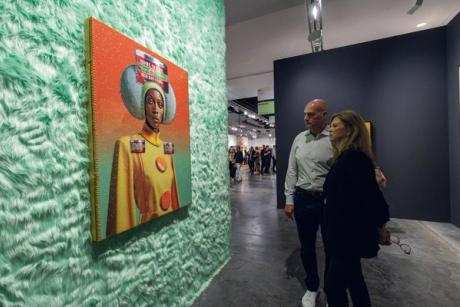I Have to Feed Myself, My Family and My Country…
- Photography (Photography)
Set of 15, 24 x 24 cm each
Hit Man Gurung
Hit Man Gurung’s series I Have to Feed Myself, My Family and My Country… addresses labor migration, a phenomenon prevalent in South Asian countries like Nepal. The laborers, most of whom are young and middle-aged, come from marginalized and underprivileged backgrounds. They leave their families back in the homeland with the dream of pursuing a better life for themselves and their families. Sadly, migrant laborers are often subjected to exploitation. Abuse, slavery and untimely deaths are common among migrant workers. Gurung’s various media artworks are also a reflection on Nepal’s rapidly changing socio-political, socio-economic scene, the ten year Nepalese Civil War (1996-2006), unstable governments and the impact it has had on the personal and professional lives of citizens. Parallel to the strong impact of global capitalism, the dramatic economic boom in Gulf countries and East Asia and their investment in infrastructure development has caused high demand for cheap labour, consequently contributing to various patterns of mass migration. During the world wars, hundreds of thousands of Nepali men were mobilized to fight for the British Army as Gurkhas. Those who joined the army almost exclusively belonged to the marginalized ethnic indigenous groups like the Gurung, Magar, Rai and Limbu. Gurung belongs to one of these ethnic groups; men from his community have been serving as Gurkhas for several generations. However, the pattern of migration has now changed. People from his and other ethnic groups are migrating as temporary laborers; most hold menial jobs that do not pay very well. Nepal’s economy is heavily dependent on the remittance sent by these workers. Nepal is one of the top nations in terms of foreign remittances as a percentage of GDP. Yet, the government has not given serious attention to the rights of migrant workers; neither has it developed better policies regarding their safety. Gurung traveled to his ancestral homeland and different parts of the country conducting research in order to explore how the social fabric of Nepal has dramatically changed over the years because of migration.
Hit Man Gurung was born in Lamjung, Nepal and is currently based in Kathmandu. Gurung’s works are concerned with some of the most pressing socio-political issues of Nepal, including internal and international mass migration, the legacy of the decade-long Maoist insurgency in the country, as well as the recent pervasive effects of global capitalism in Nepal. Coming of age after the revolution that replaced a homogenizing Hindu monarchy with a federal republic that has been acknowledging, at least nominally, the country’s profound diversity, his generation has channelled the ethos of re-founding the country’s conceptual basis, questioning every aspect of their surrounding reality. Deeply concerned with the impact of these larger forces on individuals, communities, and society at large, Gurung infuses his paintings, documentary photo collages, performance and installation works with political conviction and personal poetry. With his partner Sheelasha Rajbhandari he works as a cultural organizer in various projects and both are active as co-founders of the artist collective Artree Nepal. Together they also conceived “12 Bishakh – Camp.Hub” Post Earthquake Community Art Project, a seminal project carried out in the aftermath of the 2015 Kathmandu Valley Earthquake.
Colors:
Related works sharing similar palette
» see more

© » KADIST
Randa Maddah
2017Shot from the rooftop of her house in Majdal Shams, through a complex construction of moving mirrors, this video connects both sides of the border which has cut through Syrian Golan heights since the 1967 Six-Day war...

© » KADIST
Sofia Crespo
2023This short looped-video NFT Invertebrate Interactions by Sofia Crespo aims to capture generated impressions of diatoms...

© » THEARTNEWSPER
In pictures: focus on Caribbean artists Art market Museums & heritage Exhibitions Books Podcasts Columns Technology Adventures with Van Gogh Search Search Art Basel in Miami Beach 2023 feature In pictures: focus on Caribbean artists María Elena Ortiz, curator at the Modern Art Museum of Fort Worth, picks her favourite works at Art Basel in Miami Beach Alexander Morrison 9 December 2023 Share April Bey, COLONIAL SWAG: Not Conceited, CONVINCED! (2023) © Liliana Mora María Elena Ortiz is a trailblazing curator at the Modern Art Museum of Fort Worth (the Modern), but she also has close ties to South Florida...
Related works found in the same semantic group
» see more

© » KADIST
Pooja Gurung and Bibhusan Basnet
2018DADYAA: The Woodpeckers of Rotha by Pooja Gurung and Bibhusan Basnet illuminates a unique and seldom seen international perspective on indigenous cultures and contemporary social issues in the Nepali context...

© » KADIST
Köken Ergun and Tashi Lama
2022Nepal and China signed an agreement for the Belt and Road Initiative (BRI) in 2017...

© » KADIST
Köken Ergun and Satyam Mishra
2022Nepal and China signed an agreement for the Belt and Road Initiative (BRI) in 2017...


